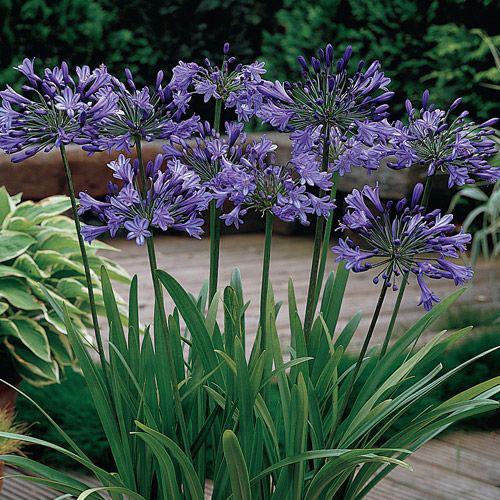Mastering the Art of Agapanthus Treatment: Essential Actions for Healthy Development and Lively Blooms
In the world of cultivation, the growing of agapanthus stands as a gratifying endeavor for those who look for to nurture these stylish blooming plants. From choosing the ideal selection to mastering trimming strategies, the trip in the direction of cultivating prospering agapanthus plants is diverse and holds the crucial to unlocking the full capacity of these agricultural treasures.

Choosing the Right Agapanthus Range

When picking the ideal Agapanthus selection for your garden, consider aspects such as climate viability, bloom color, and development routine. Agapanthus, typically known as Lily of the Nile or African lily, comes in a selection of shades varying from shades of purple and blue to white. Select a flower shade that complements your existing garden palette to create a harmonious landscape. Additionally, consider the climate in your region to make sure the Agapanthus range you pick can prosper in your details conditions. Some varieties are more forgiving of cold temperatures, while others like warmer climates. Recognizing the development habit of various Agapanthus selections is vital for correct positioning within your garden. Some ranges have a clumping development behavior, perfect for containers or boundaries, while others have a more dispersing nature, suitable for ground cover or mass growings. By carefully evaluating these aspects, you can choose the ideal Agapanthus selection to boost the beauty of your garden.
Perfect Growing Conditions
Thinking about the optimal ecological demands is necessary for successful Agapanthus cultivation. Agapanthus grows in well-draining soil with a slightly acidic to neutral pH degree. When planting, pick a place that gets complete sunshine to partial shade. In hotter environments, supplying some mid-day color can avoid scorching of the leaves. Agapanthus plants are sensitive to cold temperatures and need to be secured from frost during cold weather.
To make sure healthy and balanced growth and lively flowers, plant Agapanthus bulbs at a deepness of regarding 2-4 inches and space them 8-12 inches apart. Mulching around the base of the plants helps preserve wetness and subdues weed development.
Watering and Feeding Tips
Preserving proper wetness degrees and providing crucial nutrients are crucial elements in the treatment regimen for Agapanthus plants. When it involves watering Agapanthus, it is essential to strike an equilibrium. These plants choose regularly moist soil yet are susceptible to root rot if overwatered. Throughout the expanding season, water deeply as soon as a week, guaranteeing the soil is well-draining to avoid waterlogging. In hotter climates or during periods of dry spell, more constant watering may be necessary to maintain the soil evenly damp. However, decrease watering in the winter season to avoid water logged conditions.
Fertilizing Agapanthus is necessary for promoting healthy and balanced growth and prolific flowers. Apply a well balanced plant food, such as a 10-10-10 formula, in the early springtime as new growth emerges. By complying with these watering and feeding ideas, you can guarantee your Agapanthus plants thrive and create vibrant, durable flowers.
Trimming Methods for Agapanthus
Trimming Agapanthus plants at the appropriate times and you can look here with proper strategies is critical for maintaining their health and wellness and advertising ideal growth and blooming. The ideal time to trim Agapanthus is in late wintertime or early spring prior to brand-new development emerges. Beginning by eliminating any kind of dead or yellowing fallen leaves near the base of the plant. Cut them as close to the ground as feasible without damaging the emerging shoots.
For flowered stems, wait up until the blooms have withered and then trim them back to the base. This not just cleans up the plant's appearance but likewise urges the advancement of brand-new flower buds. Deadheading invested flowers can also redirect the plant's power into producing more blooms instead of establishing seeds. However, if you desire to accumulate seeds for breeding, leave some flowers to completely dry and mature on the plant.
Remember to utilize tidy, sharp devices to make accurate cuts and minimize the danger of introducing conditions. Agapanthus. Normal trimming will assist keep your Agapanthus looking healthy and neat while ensuring a bountiful screen of stunning blossoms
Managing Typical Bugs and Diseases
After making certain correct trimming techniques for Agapanthus, it is vital to deal with typical insects and conditions that can impact the health and vitality of these plants. Agapanthus plants are usually sturdy yet can still succumb to particular concerns. One common insect that affects Agapanthus is the Agapanthus gall midget. This little, orange fly lays its eggs in the foliage, leading to distorted growth and blossom buds that fall short to open. To fight this pest, trim and destroy any type of afflicted plant parts and consider using insecticidal soap.
Additionally, Agapanthus plants can endure from root rot if they are planted in poorly draining soil. By being attentive and taking prompt activity versus diseases and pests, you can help your Agapanthus plants grow and generate dynamic blossoms. Agapanthus.

Conclusion
Finally, mastering the art of agapanthus treatment involves selecting the ideal variety, providing suitable planting conditions, proper watering and feeding, appropriate trimming techniques, and attending to usual pests and conditions. By following sites these important actions, you can ensure healthy and balanced growth and dynamic blooms for your agapanthus plants. Keep in mind to regularly monitor and maintain your plants to advertise their general health and long life.
To make sure healthy and balanced growth and dynamic blooms, plant Agapanthus bulbs at a deepness of regarding 2-4 inches and space them 8-12 inches apart. By adhering to these watering and fertilizing tips, you can ensure your Agapanthus plants prosper and generate vivid, long-lasting blossoms.
One usual parasite that influences Agapanthus is the Agapanthus the original source gall midget. Furthermore, Agapanthus plants can experience from origin rot if they are grown in inadequately draining pipes dirt. By adhering to these crucial steps, you can ensure healthy growth and lively blossoms for your agapanthus plants.